The Thunder Child Movies Sourcebook
| A brief commercial message
Please support this site by searching for sci fi, electronics, and other goodies at Ebay through our search box, and bidding on them...and winning them! |
Keyword: Science Fiction
|
Fantastic Voyage (1966)
by Ryan Brennan
Fantastic Voyage (20th Century-Fox; CinemaScope; Color by Deluxe; 1966; 100 minutes) was a film that promised something different and fully utilized the talents of special effects technicians and production designers to make good on that promise. Utilizing many different techniques to depict the inner world of the human body, Fantastic Voyage gave captivated audiences something different but familiar.
|
Fantastic Voyage begins with the arrival of a TWA airliner. Upon landing, it is met by soldiers who pour out of military trucks and surround the plane. A black limousine brakes directly at the bottom of the debarking staircase. A trench coated man in a hat steps out and waits expectantly. The plane door opens and C.I.A. agent Grant (Stephen Boyd) steps out into the night air, quickly assessing the situation. Behind him is his charge, escaped Iron Curtain Prof. Jan Benes, a balding older man and scientist who holds a precious secret. Benes descends the staircase but, remembering, steps back up to gratefully shake Grant?s hand. Whatever he says is lost under the sound of screaming jet engines. The limo, followed by other black government cars, accelerates into the darkness under the steady gaze of Grant.
The limousine with Benes reaches the back streets of the city. Suddenly, a saboteur?s car races out of a side street, blindsiding the limo. Benes is thrown violently against the interior of the car. Gunfire rings out and a vehicle explodes in flames. Agents pull Benes from the limousine and hustle the dazed Professor into another vehicle that quickly speeds away. |
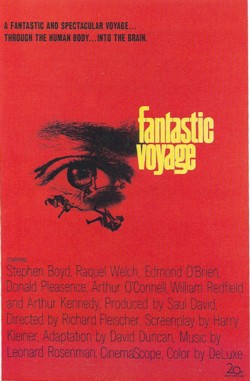
|
Benes has suffered a head injury resulting in a blood clot that cannot be removed by conventional surgery. Under a cloud of mystery Grant is summoned for a special mission. In a government facility several floors underground, Grant meets old friend General Carter (Edmond O?Brien) and Colonel Reid (Arthur O?Connell) who reveal that he will be working for the CMDB, Combined Miniaturization Deterrent Forces, a special government branch that can shrink anything down to microscopic size. Grant?s job is to provide security and serve as the communication officer for the team that will be shrunk and injected into Benes? bloodstream to remove the blood clot with a special laser instrument. Fantastic voyage, indeed.
There are two problems: 1) The miniaturization only lasts for one hour, after which white blood corpuscles will attack and consume them as they re-enlarge; and 2) An enemy agent may try to sabotage the mission.
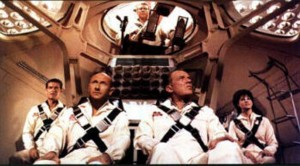
Besides Grant the team consists of the leader and navigator, Dr. Michaels (Donald Pleasence), brilliant surgeon Dr. Duval (Arthur Kennedy), his assistant Cora Peterson (Raquel Welch), and the developer of the special compact submarine, the Proteus, Capt. Bill Owens (William Redfield) who will pilot the craft.
In due course they enter the craft and are ingeniously shrunk so they may be inserted into a hypodermic needle from which they are injected into the comatose scientist. Once inside they will be tracked by a radioactive isotope in the ship and can communicate over their wireless radio. At this point the story is told in real time; the adventure will last only 60 minutes.
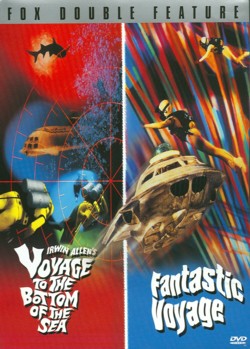 |
As soon as they are injected, though, there is trouble. An arterial venus fistula diverts them off course from the carotid artery into the jugular vein. From here they must find a new route to the blood clot through the heart or abort the mission.
Other movies have taken the viewer into outer space, journeyed below the surface of the Earth, and traveled many fathoms under the sea. Part of the thrill of these films is seeing the many astonishing sights of these "other" worlds, being awed by the beauty and strangeness of sights never before seen by humankind. This is the familiar, the journey through strange territory, wondrous beauty and danger side by side. In Fantastic Voyage the unfamiliar, the difference, is in the scenery. The inner world of microscopic cells and microbes are blown up into mesmerizing patterns, unusual shapes, and captivating colors.
Despite current claims that movies are becoming more and more dependent on their special effects, it can truly be said that Fantastic Voyage is an early example of a film wholly dependent on the achievements of the visual technicians, set designers, stunt crew and prop makers. The film did not so much push the envelope of special effects technology -- as 2001: A Space Odyssey would -- but tried pulling as many rabbits out of the Hollywood special effects hat as possible. Most of the conventional FX techniques were employed such as miniatures, oversize sets, cartoon animation, opticals and a very heavy use of both the blue screen matte and wire work. The art direction/set decoration and the visual effects won Oscars (the IMDB claims King Kong [1933] model builder Marcel Delgado worked on miniatures unaccredited).
|
A remake would today employ, no doubt, an enormous amount of CGI. People would be "floated" on green screen rigs, wires would be digitally eliminated, and the actors then digitally inserted into the exotic, even bizarre physiological world of the human body. But here the actors and stunt people mimic swimming while suspended above the soundstage, their bodies tossed and spun across huge sets representing the lungs, capillaries, the brain and inner ear. For the most part it works quite well. The sights and action are of sufficient interest to generally forgive those moments when the man behind the curtain becomes apparent.
It may also be possible to forgive some other aspects of the film that might strike the viewer as obsolete or ridiculous. However, it is impossible to overlook them. A battery of tiny radar screens forming a horseshoe shape around the still form of Benes was barely acceptable back in the day. The elevator that lowers Grant into the underground facility is a bit preposterous. Would the government actually risk placing it outside? Why not hide it in a warehouse or other structure? The underground facility itself seems outlandish and untenable, too, resembling the ramps and walkways of a major sports arena, with golf carts and scooters zipping to and fro among heavy foot traffic. References to the radio as a "wireless" seem archaic in a film that sports so much advanced technology (and tons of medical jargon and references). But these are small quibbles and shouldn?t impair the enjoyment of most viewers.
| In a film of this sort, driven by plot and visuals, the characters are not fleshed out. Harry Kleiner?s screenplay, based on a story by Otto Klement and Jerome Bixby, concentrates on getting the characters in and out of trouble and from one place to another while providing lots of medical information (and there is lots). So, Grant is the heroic C.I.A. Agent, Dr. Michaels the atheist scientist, Dr. Duval the dreamy philosopher/scientist, General Carter the no-nonsense military man, Col. Reid the medic with heart, Cora the faithful assistant and Major Owen the pilot. In each case, the actors must infuse their cardboard characters with life and vitality through force of their own screen charisma and personality. It?s been done before, done since and will be done again. It?s effectiveness rides on the success of the movie that surrounds the characters. In general it works here.
The writers occasionally insert dialogue meant to create a sense of awe and wonder (as if the visuals couldn?t accomplish that), attempts that must have been meant to give the film some weight and meaning. These lines are given to Tony winning Arthur Kennedy, an actor who can say with conviction, "Man is the center of the universe. We stand in the middle of infinity -- between inner and outer space. And there?s no limit to either." He is convincing when speaking of the "living process" or "one of the miracles of the universe." And it is between he and Donald Pleasence that any theological concerns are debated. That is, Kennedy brings them up and Pleasance is cut off before he can respond, although it is clear that his character does not believe.
|
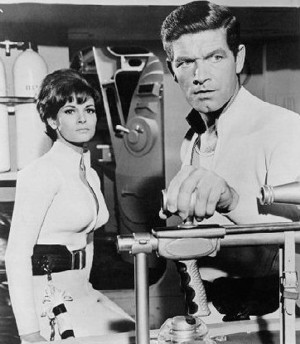 |
Edmond O?Brien, one of film?s great character actors, is handed a bit of a character trope, perhaps in honor of his stature in the industry. He has given up sugar, but events keep him pouring copious amounts of it into his coffee. (A coffee pot is precariously placed on top of military hardware.) Late in the film an ant appears among some spilled sugar granules (how did a single ant find it?s way down there?). O?Brien starts to crush it but relents, this act somehow meaning to display an inner change in his philosophy? Venerable character actor Arthur O?Connell tells him, "You?ll wind up a Hindu. They respect all forms of life however small." (There go those writers again trying to work some profundity into the proceedings.)
SaveCancelCloseEdit FileWhen finished, click Save or Cancel below. Change PermissionsReadWriteExecuteUserPart of the two-dimensional aspect of the characters may be a function of the saboteur plot. Mentioned early in the film, it is given short shrift, forgotten for about three-quarters of the movie. By the time it is resurrected the audience has been kept from learning much about the characters beyond the obvious and must therefore guess the saboteur?s identity on the most blatant evidence. Yet, at the time, some guessed incorrectly. More on this further along.
GroupOtherFile VersionsWarning: Restoring an older version will overwrite the current file without backing it up. New ArchiveArchive Name BacThe scene that caused the most talk was the one in which Raquel Welch is attacked by anti-bodies. They attack in force and cover her white scuba-suited body. Stephen Boyd manages to get her into the airlock and inside the ship. As the anti-bodies tighten up, they threaten to cut off Welch?s breathing.
Without hesitation, the men begin grabbing handfuls of the killers and pry them loose. Of course, this was considered a rather risqu?grave; sequence in 1966. Gila Golan was groped by a soldier in Our Man Flint (1966) but seldom had an actress in a major Hollywood film had so many male hands on her body. Fortunately for the filmmakers, but not for hormone inflamed viewers, the actors kept away from the controversial body parts.
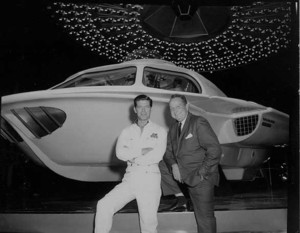
Stephen Boyd, Richard Fleischer and the Proteus
Richard Fleischer - Director
Richard Fleischer was the real navigator in this film. He had directed a not entirely dissimilar film, 20,000 Leagues Under The Sea (1954), and frequently directed big budget, complicated productions. He is handicapped by a lack of conflict in the basic story. Yes, there is man against nature, but as for man against man, that doesn?t really exist until near the film?s conclusion. And the more difficult man against himself doesn?t exist at all.
Consequently, despite the great visuals and eye candy, the storytelling is a bit bland. The cinematography (Ernest Lazlo), sound (David Dockendorf, Bernard Freericks) and editing (William B. Murphy) were all nominated for Oscars. The latter two did win awards from their individual guilds. And the film won a Hugo for Dramatic Presentation. It?s still a fun voyage.
The Musical Score
One major contribution that went without nomination was the score by Leonard Rosenman. Rosenman had been around Hollywood for years, had scored both East of Eden (1955) and Rebel Without a Cause (1955). His generally atonal mode of scoring made him perfect for psychological pictures or for giving dramatic events an unsettling edge. His score for Fantastic Voyage perfectly augments the film, at times employing a fully atonal array of instruments and sound, at others falling back into more conventional scoring to help push the sense of wonder. From this point on, Rosenman would find work scoring quite a number of films of the fantastic. (This score is available from Film Score Monthly.)
It should be mentioned that while the movie itself displays very little sense of humor (nor really needs it), whoever edited the trailer for this film definitely was having some fun. When the narrator intones, "A film called Fantastic Voyage has broken through in an unexpected direction," the words are accompanied by the moment in the film when the Proteus encounters the arterial venus fistula. "It drops the bottom out of the world you know and understand," is paired with footage of the elevator device from early in the film. And, "You are there with them, sharing a breakthrough in motion pictures," spotlights the moment the thin lung membrane is breached.
Fantastic Voyage was a box office hit, and for a couple of years in some parts of the country always seemed to be playing somewhere, popping up frequently as the second feature at the drive-in. The movie also inspired a 17 episode animated series from Filmation that featured the voices of Ted Knight (The Mary Tyler Moore Show) and Marvin Miller (the voice of Robby the Robot).
When discussing a film that is 40 years old and has easily been available both on television and home video it is easy to believe that everyone has seen the film by now. But it?s also true that some people are just young enough to have missed it. So, in the spirit of not spoiling the experience for those who might still not have seen the movie and plan on doing so, this will serve as a spoiler alert. If you don?t want key elements of the film spoiled for you, read no further.
Who Is The Saboteur?
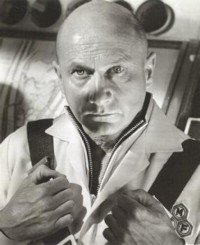 |
As mentioned earlier, the big mystery of the film is the identity of the saboteur. Many, especially with the help of hindsight and film history on their side, will guess it quite easily. That is to say that the odd, baldheaded atheist, Dr. Michaels, played by Donald Pleasence has to be the villain by the conventions of the genre. Not to mention that his repeated canting to cancel the mission throws up a red flag after awhile.
k to Control PanBut back in mid-1960s Donald Pleasance was not immediately associated with villainous roles, at least in the United States. His turn as Ernst Stavro Blofeld in the James Bond thriller You Only Live Twice (1967), the primary physical prototype for Mike Meyers? Dr. Evil in the Austin Powers films, was released the following year. (It is an irony that Pleasence would be mimicked by an actor with the same name as Pleasence?s chief film nemesis, Michael Meyers, in the Halloween films.)
At the time of Fantastic Voyage Pleasence?s greatest exposure in America had been in The Great Escape (1963) and The Hallelujah Trail (1965). In the first he played the unfortunate forger, Blythe, who is going blind, a very sympathetic role. In the latter he had a good comedic turn as Oracle Jones, the drunken prophet, in that epic Western comedy. |
But what was his exact plan for sabotaging the mission? He tries to damage the laser gun by making it look like it came loose from its mooring. He disperses a good deal of their air supply. He cuts Stephen Boyd?s lifeline. He possibly misnavigates the ship in at least one instance. Despite his caterwauling to scrub the mission, none of these attempts does anything very serious in the way of impeding the mission. It is only at the end, his bag of tricks exhausted, that he is forced to act openly, knocking out William Redfield and commandeering the Proteus. Was his plan to damage Benes? brain further? Or was he just trying to escape before he began to grow again? It?s hard to tell if he was willing to give his life to succeed or if that was all an accident. At any rate, he turns out to be a rather ineffectual saboteur.
Go to The Trailer for Fantastic Voyagea
|








